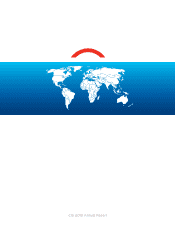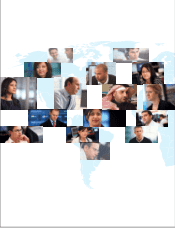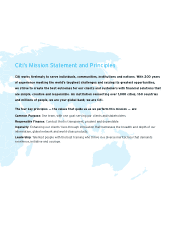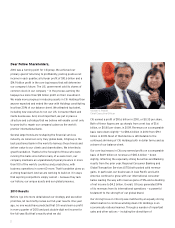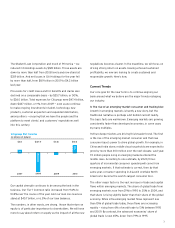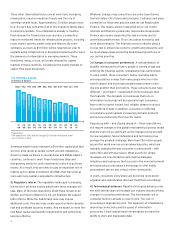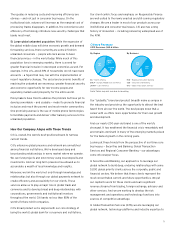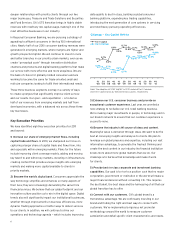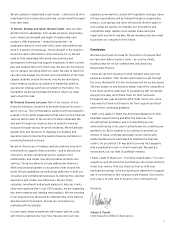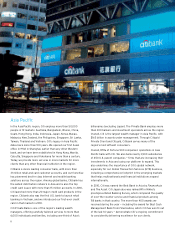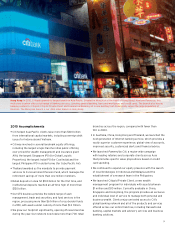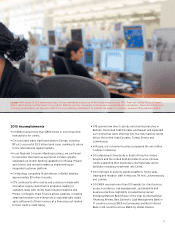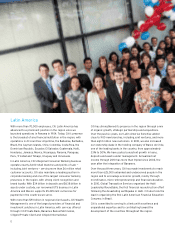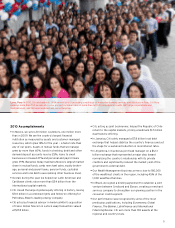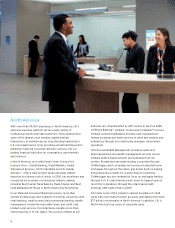Citibank 2010 Annual Report Download - page 7
Download and view the complete annual report
Please find page 7 of the 2010 Citibank annual report below. You can navigate through the pages in the report by either clicking on the pages listed below, or by using the keyword search tool below to find specific information within the annual report.
5
The upsides in reducing costs and improving efficiency are
obvious — and not just in consumer businesses. On the
institutional side, volumes will increase as the marginal cost of
processing trades disappears. In addition, the convenience and
efficiency of technology introduce new security challenges that
banks must meet.
5) Large global unbanked population: While the expansion of
the global middle class will drive economic growth and demand
for banking services, there currently are some 2.5 billion
unbanked consumers — people who lack access to basic
financial services — in the world today. While much of this
population lives in emerging markets, there is a need for
greater financial inclusion in developed economies as well. For
example, in the U.S., about 8% of households do not have bank
accounts — a figure that may rise with the implementation of
recent regulatory changes. The social and economic benefits of
reaching the unbanked are enormous: greater financial security
and economic opportunity for low-income people and
expanding markets and prosperity for the entire world.
Policymakers have tried to address the problem but have yet to
develop a workable — and scalable — model to promote financial
inclusion and reach the poorest and most remote communities.
One promising avenue is the use of mobile phone technologies
to facilitate payments and deliver other banking services to the
unbanked population.
How Our Company Aligns with These Trends
Citi is, overall, the world’s best-positioned bank to harness
current trends.
Citi’s extensive global presence and network are unmatched
among financial institutions. We’ve developed deep and
long-standing relationships in every market where we operate.
We can fund projects and lend money using local deposits and
investments. And our long-term presence has allowed us to
accumulate a wealth of local knowledge and insights.
Moreover, we link the world not only through knowledge and
relationships but also through our global payments network to
create efficiency and accessibility for our clients. These
services allow us to play a major role in global trade and
commerce and to develop broad and deep relationships with
corporations, governments and institutional investors
throughout the world. Citi banks no less than 85% of the
world’s Fortune 1,000 companies.
Citi’s broad product set is aligned with our core strategy of
being the world’s global bank for consumers and institutions.
Our client-centric focus and emphasis on Responsible Finance
are well-suited to the newly enacted and still-coming regulatory
changes. We are a leader in most of our products across our
institutional and consumer businesses. Citi also has a long
history of innovation — including pioneering widespread use of
the ATM.
Our “globality,” brand and product breadth make us unique in
the industry and provide us the opportunity to attract the best
talent from all over the world. The best people know that a
career with us offers more opportunities for their own growth
and development.
And our nearly 200-year-old brand is one of the world’s
strongest. It has weathered the financial crisis remarkably well
and remains dominant in many of the emerging markets poised
for the fastest growth in the coming years.
Looking at these trends from the perspective of our three core
businesses — Securities and Banking, Global Transaction
Services and Regional Consumer Banking — our advantages
come into sharper focus.
In Securities and Banking, our approach is to leverage our
global network to build deep, enduring relationships with some
5,000 global priority clients across the corporate, public and
financial sectors. We believe that these clients represent the
most concentrated current and future opportunities. We put
our capital to work for these clients and earn significant
revenue streams from trading, foreign exchange, advisory and
other services. And we are working to develop the risk
management and operations and technology functions into
sources of competitive advantage.
In Global Transaction Services (GTS), we are leveraging our
global network, technology platforms and industry expertise to
Citicorp Revenues
2010 Revenues: $65.6 billion
By Region By Business
RCB
49%
GTS
15%
S&B
35%
NA
41%
ASIA
22%
LATAM
19%
EMEA
18%
Note: Totals may not sum due to rounding.
RCB — Regional Consumer Banking
S&B — Securities and Banking
GTS — Global Transaction Services
NA — North America
EMEA — Europe, Middle East and Africa
LATAM — Latin America

